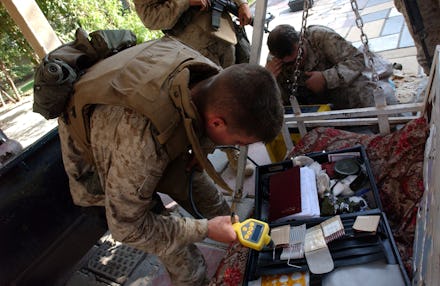Report: The CIA Bought and Destroyed Iraqi Chemical Weapons

According to a new report from the New York Times, the CIA, in cooperation with the U.S. military, secretly purchased at least 400 chemical weapons from an undisclosed Iraqi seller between 2005 and 2006.
The covert activity, termed Operation Avarice, was declared a "nonproliferation success," according to the New York Times. The goal of the mission, per a number of current and former U.S. officials, was to prevent terrorist organizations from snatching up the dangerous rockets.
Although some of the weapons weren't considered deadly, others were full of sarin — a powerful nerve agent that can cause convulsions, paralysis and death, according to the Centers for Disease Control and Prevention.
The New York Times noted that the substances' concentration was surprising given its age; the purity of the samples was about 13%, compared with samples taken in 2004, which registered about 4%. "[The 2005] rockets will be more hazardous than previously assessed," one internal memo reportedly said, per New York Times reporting.
The identity of the seller isn't publicly known, and it's also unclear how much the CIA paid for the weapons.
The CIA didn't comment on the report, and the U.S. military, for its part, didn't do a whole lot to provide clues about Operation Avarice.
"Without speaking to any specific programs, it is fair to say that together with our coalition partners in Iraq, the U.S. military worked diligently to find and remove weapons that could be used against our troops and the Iraqi people," Rear Adm. John Kirby, the Pentagon press secretary, said in a statement, according to the New York Times.
Retired Army Lt. Gen. Richard P. Zahner, who was the military's most prominent intelligence officer in Iraq at the time, stressed the mission's importance to the overall American effort in the region.
"This was a timely and effective initiative by our national intelligence partners that negated the use of these unique munitions," he told the New York Times.
The existence of these weapons had consequences. The Feb. 15 piece from the New York Times follows a previous bombshell story published by the outlet in October, which detailed the exposure of various American and Iraqi forces to chemical weapons, some of which contained sarin.
That report asserted that many American service members involved in the operation did not receive proper care following their exposure, which was in turn ascribed to the military doctors' obliviousness to the potential existence of chemical arms.
The New York Times explained the connection:
"The potency of sarin samples from the purchases, as well as tightly held assessments about risks the munitions posed, buttresses veterans' claims that during the war the military did not share important intelligence about battlefield perils with those at risk or maintain an adequate medical system for treating victims of chemical exposure."
The overarching problem appears to stem from the entire operation's lack of transparency. Neither the public nor the military as a whole knew the full story behind the chemical weapon re-collection. The latter group's ignorance of the situation was particularly damaging, as it was tasked with "fixing" the problem of Iraq's leftover rockets.
Aaron Stein, an associate fellow at the Royal United Services Institute, summed things up thusly: "If we were aware of these compounds, and as it became clear over the course of the war that our troops had been exposed to them, why wasn't more done to protect the guys on the ground?" he told the New York Times. "It speaks to the broader failure."
h/t New York Times